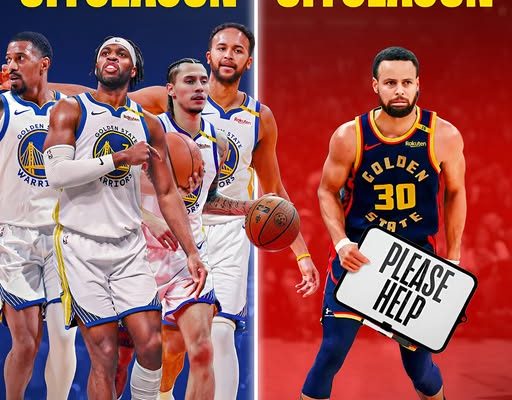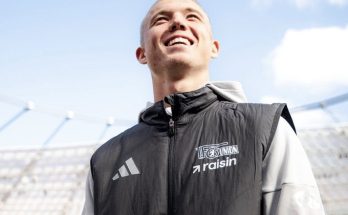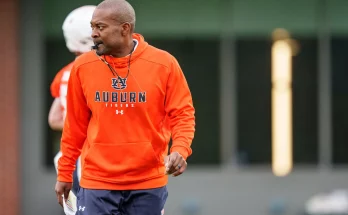Golden State Warriors’ 2025 Offseason Mirrors Past: No Blockbusters as Focus Shifts to Kuminga’s Future Amid Championship Window Closing
The Golden State Warriors find themselves once again in a familiar position as the 2025 offseason unfolds, marked by incremental tweaks rather than bold, transformative moves. After a somewhat underwhelming 2024 campaign in which the team made some additions but failed to significantly shift the needle, the Warriors now face another offseason that feels like déjà vu. Despite their effort to bolster the roster at the 2024 trade deadline by acquiring Jimmy Butler—a move intended to elevate their playoff chances—the team still fell short of making a deep postseason run. As the summer of 2025 progresses, that sense of unfulfilled potential has lingered, as the Warriors have opted for modest roster adjustments instead of pursuing a blockbuster deal that could drastically alter their trajectory.
This offseason’s narrative has not centered on the Warriors adding star power or game-changing talent. Instead, much of the attention has been directed towards the future of Jonathan Kuminga, the promising young forward who has emerged as a critical piece for Golden State’s rebuilding puzzle. Questions surrounding Kuminga’s long-term status with the franchise have dominated front-office discussions and arguably constrained their capacity or willingness to aggressively pursue major acquisitions. This focus on Kuminga’s retention has seemingly limited the Warriors’ appetite for sweeping changes, as management appears to be balancing the risks of upsetting their core against the need to remain competitive.
The Warriors’ strategy this offseason reflects a measured, if cautious, approach. They have concentrated on adding shooting, depth, and a handful of intriguing young players, moves that bolster the bench and provide valuable role players but stop short of redefining the team’s core. While these incremental additions may enhance Golden State’s overall roster flexibility and provide some insurance against injuries or fatigue, they fall short of the kind of bold acquisitions that could dramatically boost the team’s championship aspirations.
This conservative stance appears to be a calculated bet by the front office on the enduring abilities of their established stars. Stephen Curry, entering what many consider the twilight of his Hall of Fame career, remains the undisputed heart and soul of the franchise. Alongside Curry, Draymond Green continues to provide veteran leadership, defensive intensity, and playmaking prowess. The arrival of Jimmy Butler last season added a rugged two-way presence capable of delivering in high-pressure moments, further reinforcing the team’s core. The Warriors seem to be banking on this veteran trio to carry the team deep into the playoffs, hoping that their combined experience and talent can overcome any roster shortcomings.
However, this reliance on aging veterans comes with inherent risks. The NBA is a league that prizes youth, athleticism, and relentless energy, and the Warriors’ core, while undeniably skilled, is entering an age where durability and consistency can no longer be taken for granted. Injuries and wear-and-tear are factors that could derail even the most prepared teams, and Golden State’s margin for error is shrinking. For fans and analysts alike, the offseason’s lack of blockbuster moves raises uncomfortable questions about whether the franchise is truly maximizing its remaining window to contend for a championship during Curry’s final years.
Compounding the uncertainty is the question of Jonathan Kuminga’s status. The 21-year-old forward was once heralded as a cornerstone of the Warriors’ future, a high-upside player with elite athleticism and defensive potential. His development has been a focal point for the team’s front office, but recent trade rumors and contract negotiations have clouded his future in Golden State. The uncertainty surrounding Kuminga’s retention has introduced an element of instability into the roster-building process. It is widely believed that the Warriors’ hesitancy to engage in aggressive trades or signings is partly driven by their desire to resolve Kuminga’s situation first, lest they risk mortgaging future assets for short-term gains.
This offseason’s cautious maneuvering underscores a delicate balancing act for the Warriors: trying to remain competitive while preserving flexibility to either retain Kuminga or pivot toward rebuilding if circumstances demand. Such a strategy may buy time but risks alienating fans eager for more ambitious moves. It also places significant pressure on the existing core to perform at a high level without the infusion of fresh star power. The challenge is particularly pronounced given the heightened competition across the league, with teams like the Milwaukee Bucks, Boston Celtics, and Phoenix Suns continuing to strengthen their rosters with impactful additions.
Golden State’s reluctance to “swing big” this offseason contrasts sharply with the aggressive rebuilding or retooling strategies employed by many contenders. While some franchises have boldly leveraged draft capital, cap space, and trade assets to acquire multiple stars or future Hall of Famers, the Warriors have chosen a more conservative path. Their approach, emphasizing incremental improvement and internal development, reflects a belief in the existing group’s championship potential but may also indicate concerns about the cost and risks associated with blockbuster trades.
The absence of a major move also brings into sharp relief the fleeting nature of the Warriors’ championship window. The core that delivered multiple titles over the past decade is visibly aging, and the league’s landscape is shifting toward younger, faster, and more versatile teams. For Stephen Curry, a generational talent whose influence transcends the sport, the coming seasons represent the last realistic chance to add to his legacy with a championship ring. The Warriors’ front office appears keenly aware of this timeline, which only heightens the stakes for the next few campaigns.
Yet, the current trajectory suggests a missed opportunity. Without a bold roster shake-up or the addition of a bona fide star to pair alongside Curry and Butler, Golden State risks falling short of genuine title contention. Incremental improvements and depth signings, while valuable, often prove insufficient in a playoff environment where superteams clash and championship-caliber lineups require multiple stars firing simultaneously. For a franchise synonymous with innovation and excellence, this conservative offseason could signal a retreat from that ethos.
In the eyes of many analysts, the Warriors’ offseason thus far sends mixed signals about their ambition. The choice to prioritize Kuminga’s future and avoid major trades may reflect prudent management, but it also raises doubts about whether the franchise is willing to make the tough decisions necessary to remain at the pinnacle of the league. Fans, who have been spoiled by Golden State’s dominance in recent years, might view this period as a crossroads—where the team must either recommit to a championship chase with urgency or begin preparing for a rebuild.
The implications of this offseason extend beyond the immediate future. How the Warriors navigate the next steps with Jonathan Kuminga could define the franchise’s direction for years to come. If Kuminga stays and develops into the star the team hopes for, Golden State may have a sustainable foundation to compete even after Curry’s departure. Conversely, if Kuminga leaves or fails to meet expectations, the Warriors could face a difficult rebuilding process with a rapidly aging core and limited young talent.
As the Warriors head into training camp and the 2025–26 season, all eyes will be on how this roster performs in the crucible of competition. The absence of a blockbuster offseason acquisition places greater responsibility on Curry, Green, and Butler to lead by example and extract maximum performance from a roster that, while improved, lacks the star power seen on other championship contenders. The team’s ability to adapt, innovate, and overcome these challenges will determine whether this offseason’s cautious approach was wise or shortsighted.
Ultimately, the Golden State Warriors’ 2025 offseason serves as a stark reminder of the difficult choices teams face in the NBA’s evolving landscape. Balancing veteran talent with youth development, managing cap space with roster needs, and weighing short-term gains against long-term sustainability are complex tasks with no easy answers. For a franchise that has set the standard for modern basketball excellence, the stakes have never been higher. Any season falling short of a championship run during Curry’s final years risks being remembered as a missed opportunity—one that could alter the franchise’s legacy for years to come.
The path forward is clear but challenging. The Warriors must either recommit to aggressive roster building to support their aging stars or prepare for a gradual transition into a new era. With the clock ticking on Curry’s prime and Kuminga’s future uncertain, the next chapter of Golden State basketball will be defined by decisions made now. Whether that leads to another championship or a rebuilding phase remains to be seen, but the urgency and importance of these moments cannot be overstated.



